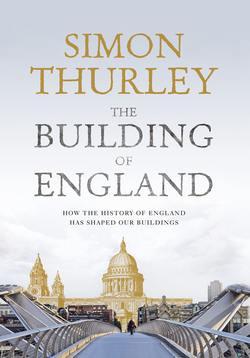Читать книгу The Building of England: How the History of England Has Shaped Our Buildings - Simon Thurley - Страница 41
A Capital City
ОглавлениеIt was during the reign of Edward I that London became a capital city in the modern sense of the word, displacing Winchester as the seat of the state and the focal point for English identity, language and law. Its population was perhaps as large as 100,000, much smaller than Paris but four times the size of its nearest rival, Norwich. The years after 1300 saw London consolidate its position as the engine-house of England’s economy. By 1306 it exported more wool than Boston, and by 1334, in terms of taxation, London was five times richer than Bristol, her nearest competitor.41
London was still surrounded by a wall with six gates, Roman in origin, and on a number of occasions during the Middle Ages these were manned to defend the City. Yet the population had already burst through the walls, especially in the west, where buildings lined the streets of the Strand and Holborn. Within the city most of the major buildings and structures that dominated its skyline to the Reformation had already been founded. The Tower and St Paul’s Cathedral have already been mentioned, but London also had monasteries and 140 parish churches, as well as London Bridge, 906ft long with 19 arches.
| The rich and powerful had houses in London from 1100, but from 1300 large numbers of bishops and abbots, and then lay nobles, built great houses or inns in London, seeking to be close to Westminster and the law courts, and to trade with each other. We have already met the pluralist Bogo de Clare (p. 134), who was typical of the very rich in having a house near Aldgate but only 950ft away also owning a substantial wardrobe – essentially an office where he could trade, entertain business contacts and conduct his financial affairs. His wardrobe had a courtyard with a well and a lawn, perhaps a chapel, too. Between 1285 and 1286 Bogo spent £375 on supplies through his wardrobe. This was big business for everyone concerned and demonstrated that aristocratic houses were crucial to the economy of the city. Their wealthy occupants spent heavily on supporting their households and equipping themselves with the latest luxuries. When Richard Swinfield, Bishop of Hereford, brought his household to London in 1291, his expenditure trebled from £1 to £3 a day.42 |
| The houses of men such as Bogo were generally set back from the street in courtyards approached by a gatehouse. Their owners would often build and rent out shops on the street front, making their houses to an extent self-supporting. At the back of the courtyard was generally the great hall and an attached chamber built up over a vaulted undercroft. Many also had towers that lifted their owners above the noise, smell and confusion of the streets to daylight and spectacular views over the rooftops. No single 14th-century house or wardrobe survives, but in Southwark parts of the Bishop of Winchester’s palace do, and these give us a glimpse of the magnificence of the richest of the residences (fig. 118). |
| Winchester Place was started in about 1200, and was extended and altered right up to the Reformation. The bishop had a separate chapel and, at right angles to this, was a suite of rooms built in the late 1350s containing a number of fine chambers, including a study and latrines. The new rooms overlooked gardens. The kitchen and domestic buildings lay to the west of the hall. The whole was bounded by walls and supplied by extensive stabling. This latter point is important as stabling was a huge problem, rather like car parking today. Pasture, fodder and a place to stable horses were crucial to the efficient existence of a nobleman, and good stables in central London were vitally important for a man of wealth.43 |
| English architecture in the period from 1220 to 1350 displays the confidence that comes with wealth and independence. Architects had mastered both the structural capabilities of Gothic architecture and its decorative possibilities. Patrons wanted to translate their ambitions into stone, timber, glass and fired clay, and were not ashamed of extravagant display. |
| England was largely made up of the estates of the aristocracy, the Church and the Crown. All created landscapes that were in equal measure devoted to power, pleasure and production. Their economic lessers aped them, but also made their own distinctive contribution. The Crown did not exclusively set the way bishops, aristocrats and merchants created new forms of building. For everyone, however, architecture was, as always, about display, whether it was at Winteringham (p. 124), All Saints’, Buckworth (p. 136), or Penshurst Place (p. 143). |
| Fig. 118 Winchester Place, Southwark in c.1400. This was a big London episcopal residence with a double courtyard and substantial garden. The bishop had his own private quarters and garden but they overlooked busy streets. The prisons related to the bishop’s jurisdiction in a notoriously unruly suburb. |
| A strengthened sense of England emerged, as distinct from Wales, Scotland and the continental territories of the Angevin kings, and its architecture was equally distinct. What is normally described as Decorated architecture does not occur anywhere else, even in Scotland and Wales, yet it pervaded all parts of England. But architectural style in this period is a phenomenon not a homogeneous movement; local and regional variation produced thousands of one-off variations. (Architecture before the 1220s and after the 1350s tends to be less individualistic than the 130-odd years of exuberance in between.)44 But boom leads to bust. The series of calamities that hit English society after 1300 came thick and fast: economic stagnation, climate change, famine and disease. All led to changes in the way that the English built. |
